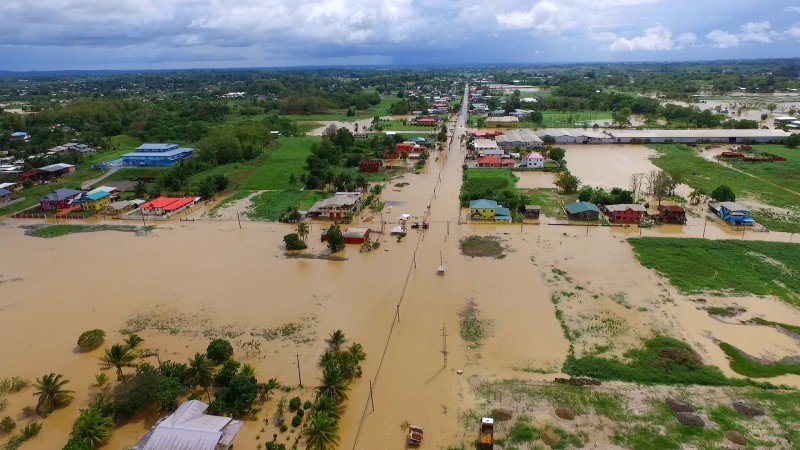A couple weeks ago, entire neighborhoods of my home country, Trinidad & Tobago, were under water after days of heavy rain. Luckily, my family wasn’t affected, but it was strange seeing pictures and videos of villages under water. While I stressed about upcoming essay deadlines, people were stranded on roofs, and some had to be rescued by boat from the brown waters that had inundated their homes.
Natural disasters have always struck me with a sense of fascination and tragedy. Whenever there is a disaster close to home, I obsessively refresh my social media news feeds, trying to glean as much information as I could. I save as many articles and videos as I can like a reporter trying to find sources for a story.
Trinidad & Tobago is a small twin-island country in the southern Caribbean. Though we’re out of the hurricane belt, we still face heavy rains during hurricane season (our rainy season) and relatively frequent, small- to mid-range earthquakes.
The most recent impactful earthquake struck on Aug. 21, while I was still at home vacationing before returning to Stanford. It was a whopping 7.0, and while there were no deaths and minimal damage, we were shaken. When the quake began, I was sitting on my bed studying for the GRE. I bolted under the sturdiest piece of furniture in my room (which happened to be a four-foot-long fold-up table) and screamed, praying to God that I wouldn’t perish. Our house rocked from side to side for at least 60 seconds (though some say it lasted up to 90 seconds), and in that moment I had no idea how it would all end.
The first aftershock big enough to feel came the next morning, when I was again laying on my bed. For days afterward my heart skipped a beat even thinking about the quake. Even now, as I climb into bed, the thought sometimes crossed my mind: What would I do if an earthquake struck now?
Back in August, I was glued to my phone — scrolling through Facebook, Whatsapp and Snapchat, hungry for information, pictures and videos. Tragedy unites. There was a sense of solidarity knowing that everyone around you had just been subject to a force of nature, over which none of us had control. Rich, poor, old, young — we all felt it and were affected.
“In all my years, that’s the biggest quake I ever felt,” my grandfather said when I visited him later that week. He’d been asleep on the couch in his porch, and the earthquake woke him up.
“What did you do?” I asked, wide-eyed and curious.
“What is there to do? I surrendered it to God and said if this is my time, then so be it,” he responded. I guess not everyone goes into a straight-up panic when disaster strikes.
In the days that followed, the earthquake was all we could talk about. I wanted to know how friends and family were doing; Was there any damage? How had they reacted? Did they run out of the house screaming, or hunker down under a piece of furniture?
But last month, when the flooding occurred, I was here at Stanford and far removed from it all. When I realized what had happened — that almost overnight highways and villages were submerged and citizens stranded — it definitely changed the mood of my weekend.
While I pushed away the stress of assignments and enjoyed sunny afternoons and bike rides across campus, people back home had lost everything. I watched from my screen as the Prime Minister officially declared the flooding a national disaster. I felt an urge to be there, to be closer to things so I could contribute where I could. But the tragedy only existed on my screen. If I looked away, I could pretend it hadn’t even happened.
This was the strange part of being so far away from home while disaster struck. It almost felt like I was imagining the whole thing. Yet I knew it was real, and that people were suffering while I sat idly at my desk. Life seemed to go on all around me, and though I tried to stay present, my heart was back in Trinidad.
As I continued to follow the news, it was heartening to see the way people back home banded together to help each other. I read stories of regular citizens using their personal boats to rescue others and neighbors cooking pots of food for the community while water lapped at their ankles. Food and donation drives had popped up across the country. I’m still thinking about how I can rally here at Stanford to help in some way, even if it’s a small contribution.
It’s been eye-opening in some ways. Stanford students come from all over the world, and every day around the world, people endure disaster and suffering. I imagine that other students have been in similar situations.
Just last year, a couple weeks before classes began, Hurricanes Irma, Maria and Jose ravaged Caribbean islands, including Puerto Rico, the U.S. Virgin Islands and Antigua and Barbuda. Stanford students were directly affected and I can’t imagine what that must have been like. Our community hosted a benefit concert to support the relief efforts, and students shared their stories, including the difficulties of returning to Stanford in the midst of disaster. However, they showed resilience. It’s good to know that in the face of disaster, resilience and unity shine through.
Contact Astrid Casimire at acasimir ‘at’ stanford.edu.
